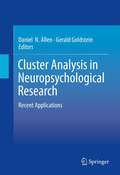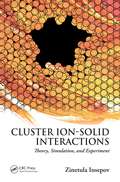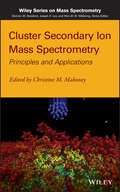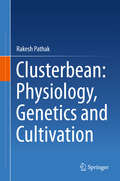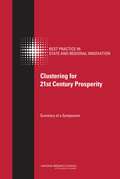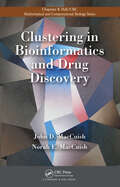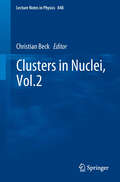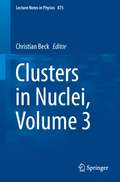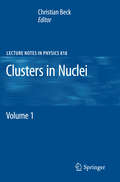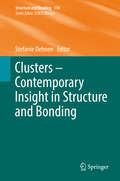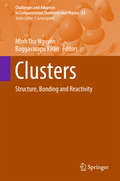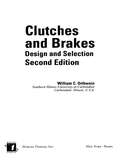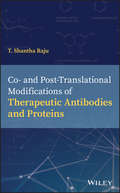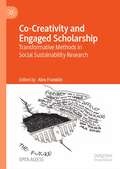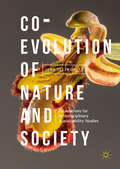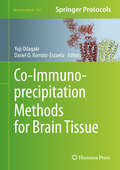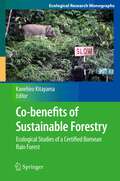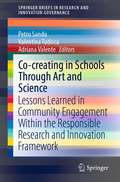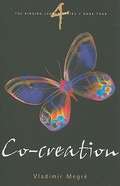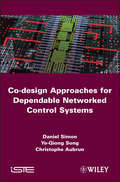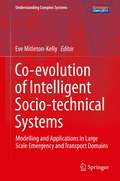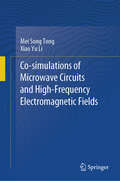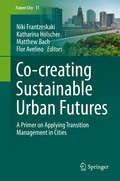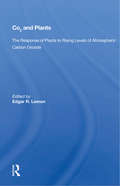- Table View
- List View
Cluster Analysis in Neuropsychological Research: Recent Applications
by Daniel N. Allen Gerald GoldsteinCluster analysis is a multivariate classification technique that allows for identification of homogenous subgroups within diverse samples based on shared characteristics. In recent years, cluster analysis has been increasingly applied to psychological and neuropsychological variables to address a number of empirical questions. This book provides an overview of cluster analysis, including statistical and methodological considerations in its application to neurobehavioral variables. First, an introduction to cluster analysis is presented that emphasizes issues of relevance to neuropsychological research, including controversies surrounding it use. Cluster analysis is then applied to clinical disorders that do not have an associated prototypical neuropsychological profile, including traumatic brain injury, schizophrenia, and health problems associated with homelessness. In a second application, cluster analysis is used to investigate the course of normal memory development. Finally, cluster analysis is applied to classification of brain injury severity in children and adolescents who sustained traumatic brain injury.
Cluster Ion-Solid Interactions: Theory, Simulation, and Experiment
by Zinetula InsepovCluster Ion-Solid Interactions: Theory, Simulation, and Experiment provides an overview of various concepts in cluster physics and related topics in physics, including the fundamentals and tools underlying novel cluster ion beam technology. The material is based on the author's highly regarded courses at Kyoto University, Purdue University, the Mos
Cluster Secondary Ion Mass Spectrometry
by Christine M. MahoneyExplores the impact of the latest breakthroughs in cluster SIMS technology Cluster secondary ion mass spectrometry (SIMS) is a high spatial resolution imaging mass spectrometry technique, which can be used to characterize the three-dimensional chemical structure in complex organic and molecular systems. It works by using a cluster ion source to sputter desorb material from a solid sample surface. Prior to the advent of the cluster source, SIMS was severely limited in its ability to characterize soft samples as a result of damage from the atomic source. Molecular samples were essentially destroyed during analysis, limiting the method's sensitivity and precluding compositional depth profiling. The use of new and emerging cluster ion beam technologies has all but eliminated these limitations, enabling researchers to enter into new fields once considered unattainable by the SIMS method. With contributions from leading mass spectrometry researchers around the world, Cluster Secondary Ion Mass Spectrometry: Principles and Applications describes the latest breakthroughs in instrumentation, and addresses best practices in cluster SIMS analysis. It serves as a compendium of knowledge on organic and polymeric surface and in-depth characterization using cluster ion beams. It covers topics ranging from the fundamentals and theory of cluster SIMS, to the important chemistries behind the success of the technique, as well as the wide-ranging applications of the technology. Examples of subjects covered include: Cluster SIMS theory and modeling Cluster ion source types and performance expectations Cluster ion beams for surface analysis experiments Molecular depth profiling and 3-D analysis with cluster ion beams Specialty applications ranging from biological samples analysis to semiconductors/metals analysis Future challenges and prospects for cluster SIMS This book is intended to benefit any scientist, ranging from beginning to advanced in level, with plenty of figures to help better understand complex concepts and processes. In addition, each chapter ends with a detailed reference set to the primary literature, facilitating further research into individual topics where desired. Cluster Secondary Ion Mass Spectrometry: Principles and Applications is a must-have read for any researcher in the surface analysis and/or imaging mass spectrometry fields.
Clusterbean: Physiology, Genetics and Cultivation (SpringerBriefs in Plant Science)
by Rakesh PathakThis book provides in-depth information on clusterbean, its cultivation, genetic improvement, plant protection measures, management of abiotic stresses, molecular aspects etc. It is divided into seven chapters including an introduction to the crop, prospects, constraints, genetic improvement, variability, application of clusterbean gum and its byproducts, cultivation, plant protection, physiological and abiotic stress aspects, along with related genetic markers and biotechnological advances. Clusterbean (Cyamopsis tetragonoloba (L. ) Taub. ), commonly known as 'guar,' is an important leguminous crop grown for seed, green fodder, vegetable and green manuring in arid and semi-arid regions and has a special commercial role due to the gum content in its seeds. India's arid environment provides ideal agro-climatic conditions for the successful cultivation of clusterbean, as the plant needs little surface water, long-duration sunshine and low relative humidity during the cropping season. India accounts for nearly 82 percent of global clusterbean seed production, making it an important export product. Based on essential industry and market data, the book offers a comprehensive overview of this unique crop, and will be of interest to researchers active in the field of clusterbean breeding.
Clustering for 21st Century Prosperity: Summary of a Symposium
by Charles W. WessnerResponding to the challenges of fostering regional growth and employment in an increasingly competitive global economy, many U. S. states and regions have developed programs to attract and grow companies as well as attract the talent and resources necessary to develop regional innovation clusters. These state and regionally based initiatives have a broad range of goals and increasingly include larger resources commitments, often with a sectoral focus and often in partnership with foundations and universities. Recent studies, however, have pointed out that many of these efforts lack the scale and the steady commitment needed for success. This has prompted new initiatives to coordinate and concentrate investments from a variety of federal agencies to develop research parks, business incubators, and other strategies to encourage entrepreneurships and high-tech development in the nation's regions. Understanding the nature of innovation clusters and public policies associated with successful cluster development is therefore of current relevance. Clustering for 21st Century Prosperity identifies best practices with regard to goals, structures, instruments, modes of operation, synergies across private and public programs, funding mechanisms and levels, and evaluation efforts. The committee, under the Board on Science, Technology, and Economic Policy (STEP) is reviewing selected state and regional efforts to capitalize on federal and state investments in areas of critical national needs. This review includes both efforts to strengthen existing industries as well as specific technology focus areas such as nanotechnology, stem cells, and advanced energy in order to better understand program goals, challenges, and accomplishments. As part of this study, the committee is convening a series of public workshops and symposia involving responsible local, state, and federal officials and other stakeholders. Drawing from discussions at these symposia, fact-finding meetings, and commissioned analyses of existing state and regional programs and technology focus areas, the committee will subsequently produce a final report with findings and recommendations focused on lessons, issues, and opportunities for complementary U. S. policies created by these state and regional initiatives.
Clustering in Bioinformatics and Drug Discovery (Chapman & Hall/CRC Computational Biology Series)
by John David MacCuish Norah E. MacCuishWith a DVD of color figures, Clustering in Bioinformatics and Drug Discovery provides an expert guide on extracting the most pertinent information from pharmaceutical and biomedical data. It offers a concise overview of common and recent clustering methods used in bioinformatics and drug discovery.Setting the stage for subsequent material, the firs
Clusters in Automotive and Information & Communication Technology: Innovation, Multinationalization and Networking Dynamics
by Paul J.J. WelfensInformation & communication technology (ICT) and the automotive sector are two of the most important industries in the EU and the US. The EU's eastern expansion and economic globalization have reinforced competition on the one hand; on the other hand the importance of outsourcing and off-shoring has increased. Against this background the intensification of innovation dynamics becomes crucial - and with them the role of regional innovation clusters. The analysis examines seven regions and six EU countries. The focus is on cluster and network dynamics in both industries, as regional ICT clusters are playing an increasingly central role in many European regions. Specialization and structural change in the automotive sector are highlighted, and new strategic approaches for multinational companies and changes in policy options are identified.
Clusters in Nuclei, Vol.2 (Lecture Notes in Physics #848)
by Christian BeckFollowing the pioneering discovery of alpha clustering and of molecular resonances, the field of nuclear clustering is today one of those domains of heavy-ion nuclear physics that faces the greatest challenges, yet also contains the greatest opportunities. After many summer schools and workshops, in particular over the last decade, the community of nuclear molecular physicists has decided to collaborate in producing a comprehensive collection of lectures and tutorial reviews covering the field. This second volume follows the successful Lect. Notes Phys. 818 (Vol.1), and comprises six extensive lectures covering the following topics: Microscopic cluster models Neutron halo and break-up reactions Break-up reaction models for two- and three-cluster projectiles Clustering effects within the di-nuclear model Nuclear alpha-particle condensates Clusters in nuclei: experimental perspectives By promoting new ideas and developments while retaining a pedagogical style of presentation throughout, these lectures will serve as both a reference and an advanced teaching manual for future courses and schools in the fields of nuclear physics and nuclear astrophysics.
Clusters in Nuclei, Volume 3 (Lecture Notes in Physics #875)
by Christian BeckFollowing the pioneering discovery of alpha clustering and of molecular resonances, the field of nuclear clustering is today one of those domains of heavy-ion nuclear physics that faces the greatest challenges, yet also contains the greatest opportunities. After many summer schools and workshops, in particular over the last decade, the community of nuclear molecular physicists has decided to collaborate in producing a comprehensive collection of lectures and tutorial reviews covering the field. This third volume follows the successful Lect. Notes Phys. 818 (Vol. 1) and 848 (Vol. 2), and comprises six extensive lectures covering the following topics: - Gamma Rays and Molecular Structure - Faddeev Equation Approach for Three Cluster Nuclear Reactions - Tomography of the Cluster Structure of Light Nuclei Via Relativistic Dissociation - Clustering Effects Within the Dinuclear Model : From Light to Hyper-heavy Molecules in Dynamical Mean-field Approach - Clusterization in Ternary Fission - Clusters in Light Neutron-rich Isotopes By promoting new ideas and developments while retaining a pedagogical style of presentation throughout, these lectures will serve as both a reference and an advanced teaching manual for future courses and schools in the fields of nuclear physics and nuclear astrophysics.
Clusters in Nuclei: Volume 1 (Lecture Notes in Physics #818)
by Christian BeckFollowing the pioneering discovery of alpha clustering and of molecular resonances, the field of nuclear clustering is presently one of the domains of heavy-ion nuclear physics facing both the greatest challenges and opportunities. After many summer schools and workshops, in particular over the last decade, the community of nuclear molecular physics decided to team up in producing a comprehensive collection of lectures and tutorial reviews covering the field. This first volume, gathering seven extensive lectures, covers the follow topics: * Cluster Radioactivity * Cluster States and Mean Field Theories * Alpha Clustering and Alpha Condensates * Clustering in Neutron-rich Nuclei * Di-neutron Clustering * Collective Clusterization in Nuclei * Giant Nuclear Molecules By promoting new ideas and developments while retaining a pedagogical nature of presentation throughout, these lectures will both serve as a reference and as advanced teaching material for future courses and schools in the fields of nuclear physics and nuclear astrophysics.
Clusters – Contemporary Insight in Structure and Bonding (Structure and Bonding #174)
by Stefanie DehnenChemical structure and bonding. The scope of the series spans the entire Periodic Table and addresses structure and bonding issues associated with all of the elements. It also focuses attention on new and developing areas of modern structural and theoretical chemistry such as nanostructures, molecular electronics, designed molecular solids, surfaces, metal clusters and supramolecular structures. Physical and spectroscopic techniques used to determine, examine and model structures fall within the purview of Structure and Bonding to the extent that the focus is on the scientific results obtained and not on specialist information concerning the techniques themselves. Issues associated with the development of bonding models and generalizations that illuminate the reactivity pathways and rates of chemical processes are also relevant. The individual volumes in the series are thematic. The goal of each volume is to give the reader, whether at a university or in industry, a comprehensive overview of an area where new insights are emerging that are of interest to a larger scientific audience.
Clusters: Structure, Bonding and Reactivity (Challenges and Advances in Computational Chemistry and Physics #23)
by Minh Tho Nguyen Boggavarapu KiranThe field of atomic clusters continues to attract great interest amongst physicists and chemists alike. This is in part due to their intrinsic properties and potential industrial applications. The first part of Binary Clusters is devoted to recent developments in experimental techniques, the second part covers a variety of theoretical approaches. Different theoretical methods based on group/graph theories and quantum chemical computational methods as well as various spectroscopy techniques (such as mass, laser, infrared, photoelectron etc. ) are applied to the determination of the existence of geometrical and electronic structures, chemical bonding phenomena, and the thermodynamic stabilities of several classes of binary clusters. All chapters within this review volume have been contributed by experts in chemistry, physics, and material sciences based at the University of Leuven, Belgium. This book is aimed at professionals and students working in cluster science.
Clutches and Brakes: Design and Selection
by William C. OrthweinConveniently gathering formulas, analytical methods, and graphs for the design and selection of a wide variety of brakes and clutches in the automotive, aircraft, farming, and manufacturing industries, Clutches and Brakes: Design and Selection, Second Edition simplifies calculations, acquaints engineers with an expansive range of application, and a
Co- and Post-Translational Modifications of Therapeutic Antibodies and Proteins
by T. Shantha RajuA Comprehensive Guide to Crucial Attributes of Therapeutic Proteins in Biological Pharmaceuticals With this book, Dr. Raju offers a valuable resource for professionals involved in research and development of biopharmaceutical and biosimilar drugs. This is a highly relevant work, as medical practitioners have increasingly turned to biopharmaceutical medicines in their search for safe and reliable treatments for complex diseases, while pharmaceutical researchers seek to expand the availability of biopharmaceuticals and create more affordable biosimilar alternatives. Readers receive a thorough overview of the major co-translational modifications (CTMs) and post-translational modifications (PTMs) of therapeutic proteins relevant to the development of biotherapeutics. The majority of chapters detail individual CTMs and PTMs that may affect the physicochemical, biochemical, biological, pharmacokinetic, immunological, toxicological etc. properties of proteins. In addition, readers are guided on the methodology necessary to analyze and characterize these modifications. Thus, readers gain not only an understanding of CTMs/PTMs, but also the ability to design and assess their own structure-function studies for experimental molecules. Specific features and topics include: Discussion of the research behind and expansion of biopharmaceuticals Twenty chapters detailing relevant CTMs and PTMs of proteins, such as glycosylation, oxidation, phosphorylation, methylation, proteolysis, etc. Each chapter offers an introduction and guide to the mechanisms and biological significance of an individual CTM or PTM, including practical guidance for experiment design and analysis An appendix of biologic pharmaceuticals currently on the market, along with an assessment of their PTMs and overall safety and efficacy This volume will prove a key reference on the shelves of industry and academic researchers involved in the study and development of biochemistry, molecular biology, biopharmaceuticals and proteins in medicine, particularly as biopharmaceuticals and biosimilars become ever more prominent tools in the field of healthcare.
Co-Creativity and Engaged Scholarship: Transformative Methods in Social Sustainability Research
by Alex FranklinThis open access book explores creative and collaborative forms of research praxis within the social sustainability sciences. The term co-creativity is used in reference to both individual methods and overarching research approaches. Supported by a series of in-depth examples, the edited collection critically reviews the potential of co-creative research praxis to nurture just and transformative processes of change. Included amongst the individual chapters are first-hand accounts of such as: militant research strategies and guerrilla narrative, decolonial participative approaches, appreciative inquiry and care-ethics, deep-mapping, photo-voice, community-arts, digital participatory mapping, creative workshops and living labs. The collection considers how, through socially inclusive forms of action and reflection, such co-creative methods can be used to stimulate alternative understandings of why and how things are, and how they could be. It provides illustrations of (and problematizes) the use of co-creative methods as overtly disruptive interventions in their own right, and as a means of enriching the transformative potential of transdisciplinary and more traditional forms of social science research inquiry. The positionality of the researcher, together with the emotional and embodied dimensions of engaged scholarship, are threads which run throughout the book. So too does the question of how to communicate sustainability science research in a meaningful way.
Co-Evolution of Nature and Society: Foundations for Interdisciplinary Sustainability Studies
by Jens JetzkowitzThis book offers support for interdisciplinary research on the interactions of nature and society. It is based on the hypothesis that a science of coevolution is needed to explore paths to a sustainable future. Jens Jetzkowitz initially discusses why social science knowledge only rarely finds its way into sustainability discourse. One significant issue is a view of science that separates knowing and acting, and the book illustrates current problems in conceptualising interdisciplinary knowledge production. It then goes one step further and introduces a workable alternative concept, taking philosophical pragmatism as a point of departure. Sustainable development goals and transdisciplinarity are currently subject to widespread discussions and Jetzkowitz takes a stance on the debates from the perspective of coevolutionary science.This book will appeal to scholars and students interested in environmental and sustainability discourses and to anyone willing to think outside the box.
Co-Immunoprecipitation Methods for Brain Tissue (Neuromethods #144)
by Dasiel O. Borroto-Escuela Yuji OdagakiThis volume covers various aspects of co-immunoprecipitation (co-IP) methods and its relevant use in studying protein-protein interactions (PPIs) in health and diseases of the Central Nervous System. The chapters in this book discuss topics such as using co-IP to detect G protein-coupled receptors (GPCR), receptor tyrosine kinases (RTK) and ion channels heteroreceptor complexes in brain tissue; the histoblot technique; interaction strength between synaptic proteins using COS-7; and co-IP analysis of the protein-protein interactions in the neurons of Polymita. In Neuromethods series style, chapters include the kind of detail and key advice from the specialists needed to get successful results in your laboratory.Cutting-edge and thorough, Co-Immunoprecipitation Methods for Brain Tissue is a valuable resource for any researcher interesting in learning more about this developing field.
Co-benefits of Sustainable Forestry: Ecological Studies of a Certified Bornean Rain Forest (Ecological Research Monographs)
by Kanehiro KitayamaTropical rain forests are increasingly expected to serve for climate change mitigation and biodiversity conservation amid global climate change and increasing human demands for land. Natural production forests that are legally designated to produce timber occur widely in the Southeast Asian tropics. Synergizing timber production, climate change mitigation and biodiversity conservation in such tropical production forests is one of the most realistic means to resolve these contemporary global problems. Next-generation sustainable forest management is being practiced in the natural tropical rain forest of a model site in Sabah, Malaysian Borneo, while earlier sustainable management practices have generally failed, leading to extensive deforestation and forest degradation elsewhere in the tropics. Ecologists have examined co-benefits of sustainable forestry in the model forest in terms of forest regeneration, carbon sequestration and biodiversity in comparison to a forest managed by destructive conventional methods. Taxonomic groups studied have included trees, decomposers, soil microbes, insects and mammals. A wide array of field methods and technology has been used including count plots, sensor cameras, and satellite remote-sensing. This book is a compilation of the results of those thorough ecological investigations and elucidates ecological processes of tropical rain forests after logging. The book furnishes useful information for foresters and conservation NGOs, and it also provides baseline information for biologists and ecologists. A further aim is to examine the environmental effects of a forest certification scheme as the model forest has been certified by the Forest Stewardship Council. Taken as a whole, this book proves that the desired synergy is possible.
Co-creating in Schools Through Art and Science: Lessons Learned in Community Engagement Within the Responsible Research and Innovation Framework (SpringerBriefs in Research and Innovation Governance)
by Adriana Valente Valentina Tudisca Petru SanduThis book represents an applied, up-to-date work on RRI developments and their potential positive impact on societies. The societal challenges of the 21st century require the ability to integrate the knowledge and expertise of different societal actors, using more innovative, efficient and open approaches. Educational methodologies are in perpetual development in their attempt to provide tentative answers to three ever-changing digital age challenges: the challenge of speed, the challenge of form/at and the challenge of persistency. The current book aims to address these issues by presenting relevant case studies in the field of art, science and giving value to territory that, by the means of projects and initiatives using RRI consistent methodologies, have succeeded in their attempt to: preserve and valorise cultural heritage by using digital storytelling or crowddreaming methodology, develop educational strategies grounded on RRI and Open Schooling principles, contribute to new ways of thinking in the school environment by using RRI and promote gender equality and stimulate critical reflections on women’s role in science by the means of storytelling and RRI concepts.
Co-creation (The Ringing Cedars Series #4)
by Vladimir Megré John Woodsworth Leonid SharashkinIf you wish to gain as full an appreciation as possible of the ideas, thoughts and images set forth here, as well as experience the benefits that come with this appreciation, we recommend you find a quiet place for your reading where there is the least possible interference from artificial noises (motor traffic, radio, TV, household appliances etc.). Natural sounds, on the other hand -- the singing of birds, for example, or the patter of rain, or the rustle of leaves on nearby trees -- maybe a welcome accompaniment to the reading process.
Co-design Approaches to Dependable Networked Control Systems
by Daniel Simon Christophe Aubrun Ye-Qiong SongThis book describes co-design approaches, and establishes the links between the QoC (Quality of Control) and QoS (Quality of Service) of the network and computing resources. The methods and tools described in this book take into account, at design level, various parameters and properties that must be satisfied by systems controlled through a network. Among the important network properties examined are the QoC, the dependability of the system, and the feasibility of the real-time scheduling of tasks and messages. Correct exploitation of these approaches allows for efficient design, diagnosis, and implementation of the NCS. This book will be of great interest to researchers and advanced students in automatic control, real-time computing, and networking domains, and to engineers tasked with development of NCS, as well as those working in related network design and engineering fields.
Co-evolution of Intelligent Socio-technical Systems: Modelling and Applications in Large Scale Emergency and Transport Domains (Understanding Complex Systems)
by Evangelia Mitleton-KellyAs the interconnectivity between humans through technical devices is becoming ubiquitous, the next step is already in the making: ambient intelligence, i.e. smart (technical) environments, which will eventually play the same active role in communication as the human players, leading to a co-evolution in all domains where real-time communication is essential. This topical volume, based on the findings of the Socionical European research project, gives equal attention to two highly relevant domains of applications: transport, specifically traffic, dynamics from the viewpoint of a socio-technical interaction and evacuation scenarios for large-scale emergency situations. Care was taken to investigate as much as possible the limits of scalability and to combine the modeling using complex systems science approaches with relevant data analysis.
Co-simulations of Microwave Circuits and High-Frequency Electromagnetic Fields
by Mei Song Tong Xiao Yu LiThis book aims to provide many advanced application topics for microwave circuits and high-frequency electromagnetic (EM) fields by using advanced design system (ADS) and high-frequency structure simulator (HFSS) as simulation platforms. In particular, it contains the latest multidisciplinary co-simulation guidance on the design of relevant components and devices. Currently, the circuit/field design and performance analysis and optimization strongly rely on various kinds of robust electronic design automation (EDA) software. RF/microwave engineers must grasp two or more types of related simulation design software. ADS by Keysight and HFSS by Ansys are the representative for circuit simulations and for field and structural simulations of microwave devices, respectively. At present, these two types of software are widely used in enterprises, universities, and research institutions. The main purpose of this book is to enable readers, who are interested in microwave engineering and applied electromagnetics, to master the applications of these two tools. It also helps readers expand their knowledge boundaries behind those types of software and deepen their understanding of developing interdisciplinary technologies by co-simulations. The book is divided into three parts. The first part introduces the two latest versions of ADS and HFSS and helps readers better understand the basic principles and latest functions better. It also advises how to choose appropriate simulation tools for different problems. The second part mainly describes co-simulations for high-frequency EM fields, microwave circuits, antenna designs, EM compatibility (EMC), and thermal and structural analyses. It provides guides and advices on performing co-simulations by ADS and HFSS incorporated with other types of software, respectively. The last part narrates the automation interfaces and script programming methods for co-simulations. It primarily deals with the Advanced Extension Language (AEL), Python Data Link (PDL), and MATLAB interface in ADS. For HFSS, it discusses VBScript, IronPython scripting, and Application Programming Interface (APIs) based on MATLAB. Each topic contains practical examples to help readers understand so that they can gain a solid knowledge and skills regarding automated interfaces and scripting methods based on these kinds of software. Concisely written in combination with practical examples, this book is very suitable as a textbook in introductory courses on microwave circuit and EM simulations and also as a supplementary textbook in many courses on electronics, microwave engineering, communication engineering, and related fields. As well, it can serve as a reference book for microwave engineers and researchers.
Co-creating Sustainable Urban Futures: A Primer on Applying Transition Management in Cities (Future City #11)
by Niki Frantzeskaki Katharina Hölscher Matthew Bach Flor AvelinoThis is a unique book that provides rich knowledge on how to understand and actively contribute to urban sustainability transitions. The book combines theoretical frameworks and tools with practical experiences on transition management as a framework that supports urban planning and governance towards sustainability. The book offers the opportunity to become actively engaged in working towards sustainable futures of cities. Readers of this book will be equipped to understand the complexity of urban sustainability transitions and diagnose persistent unsustainability problems in cities. Urban planners and professionals will build competences for designing transition management processes in cities and engaging with multidisciplinary knowledge in solution-seeking processes. The heart of the book marks the variety of very different local case studies across the world - including, amongst others, Rotterdam in the Netherlands, La Botija in Honduras, Sydney in Australia and Cleveland in the US. These rich studies give inspiration and practical insights to young planners on how to create sustainable urban futures in collaboration with other stakeholders. The case studies and critical reflections on applications of transition management in cities offer food for thought and welcome criticism. They also introduce new lenses to understand the bigger picture that co-creation dynamics play in terms of power, (dis-)empowerment, legitimacy and changing actor roles. This will equip the readers with a deep understanding of the dynamics, opportunities and challenges present in urban contexts and urban sustainability transitions.
Co2 And Plants: The Response Of Plants To Rising Levels Of Atmospheric Carbon Dioxide
by Edgar R. LemonThis book presents information on the direct effects of increased atmospheric CO2 on plants. It considers what we already know about plant responses to various CO2 concentrations. .
